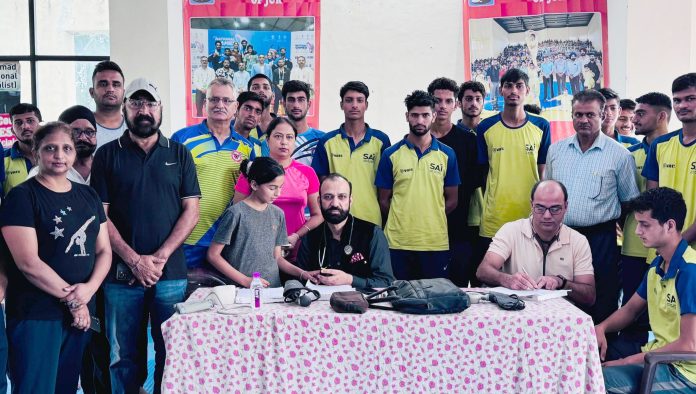
Excelsior Correspondent
Jammu, July 28 : With ever increasing incidence of cardiac ailments in sportspersons who are usually seen as icon in case of physical and mental fitness, Head Department of Cardiology GMCH Jammu Dr Sushil Sharma held a day long cardiac awareness cum health check up camp at Maulana Azad Stadium Jammu with main emphasis on primary prevention and routine cardiac checkup so as to decrease the cardiac mortality and morbidity.
While interacting with the people, Dr Sushil stated that variety of cardiovascular diseases have been identified as potential causes of sudden death in young competitive athletes (35 years old). “The vast majority of these deaths occur on the athletic field during severe exertion in the context of training or competition. Each of the responsible diseases is also known to cause sudden death in nonathletes also. The most common cause of sudden death in young athletes appears to be HCM. Less common causes are a variety of congenital coronary artery anomalies, myocarditis, dilated cardiomyopathy, Marfan’s syndrome, and right ventricular dysplasia. Uncommon but reported causes of these athletic field catastrophies include sarcoid, mitral valve prolapse, aortic valve stenosis, atherosclerotic coronary artery disease, and QT-interval prolongation syndromes,” he said.
Dr Sushil elaborated that In highly trained athletes with substantial left ventricular hypertrophy, it is of critical importance to clarify whether the increased left ventricular wall thickness represents the expression of the physiological adaptation of the heart to athletic training or a pathological condition such as hypertrophic cardiomyopathy. “While at present there is no single approach that will definitively resolve this question in all such athletes, several strategies are described here that alone or in combination offer a large measure of clarification in most instances for this often compelling diagnostic dilemma. Intense training and exercise increase the body’s need for oxygen. The heart is vital as the engine that supplies oxygen-rich blood to the muscles. With regular, vigorous aerobic activity, an athlete’s heart begins to change over time, growing larger and stronger with increased capacity. Physical activity, especially mild to moderate exercise, is beneficial in many ways. It reduces the risk of chronic disease, improves balance and coordination, helps you lose weight, and even boosts self-esteem. Highly strenuous physical activities, however, can potentially put uncertain stress on the heart,” Dr Sharma said.
He added that we see athletes as healthy, physically fit, and able to tolerate extremes of physical endurance. It seems improbable that such athletes may have, on occasion, underlying life-threatening cardiovascular abnormalities. Regular physical activity promulgates cardiovascular fitness and lowers the risk of cardiac disease.
Others who were part of this camp include Dr Dhaneshwar Kapoor . Paramedics and volunteers include Raghav Rajput, Maninder Singh , Paramveer Singh ,Jatin Bhasin , Ranjeet Singh, Rajinder Singh, Gourav Sharma , Amnish Datta and Nirvair Singh Bali.

